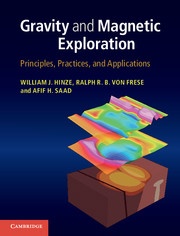Book contents
- Frontmatter
- Dedication
- Contents
- Preface
- Acknowledgements
- 1 Introduction
- Part I Gravity exploration
- 2 The gravity method
- 3 Gravity potential theory
- 4 Density of Earth materials
- 5 Gravity data acquisition
- 6 Gravity data processing
- 7 Gravity anomaly interpretation
- Part II Magnetic exploration
- Part III Applications
- Appendix A Data systems processing
- References
- Index
7 - Gravity anomaly interpretation
from Part I - Gravity exploration
Published online by Cambridge University Press: 05 May 2013
- Frontmatter
- Dedication
- Contents
- Preface
- Acknowledgements
- 1 Introduction
- Part I Gravity exploration
- 2 The gravity method
- 3 Gravity potential theory
- 4 Density of Earth materials
- 5 Gravity data acquisition
- 6 Gravity data processing
- 7 Gravity anomaly interpretation
- Part II Magnetic exploration
- Part III Applications
- Appendix A Data systems processing
- References
- Index
Summary
Overview
Raw gravity observations are reduced for their non-geologic effects to one of a variety of anomalies which in turn are processed by isolation and enhancement procedures into residual anomalies that map the gravity effects of interest in interpretation. Anomaly interpretation, which models the gravity anomalies for the nature and processes of the subsurface, is a relatively straightforward process compared with the measurement, reduction, and residual-regional separation phases of the gravity method. However, anomaly interpretation is never unique, owing to the ubiquitous presence of data errors and the inherent source ambiguity of the gravity potential. Thus, ancillary geological, geophysical, and other constraints on the subsurface are essential to help limit the ambiguity.
Gravity interpretations can be qualitative where the analysis objectives are satisfied by the mere presence or absence of an anomaly. Interpretation also can be highly quantitative with comprehensive modeling of the geometric and physical properties of the anomaly sources. Effective interpretation requires knowledge of the key geological variables that influence the anomaly's amplitude and geometry. It also requires an understanding of the key geophysical variables that control the inverse problem of estimating source parameters from the anomaly.
Gravity interpretation generally is initiated using simplified techniques to estimate preliminary source depths, depth extents, margins, density contrast, and mass. These estimates are often enhanced by more comprehensive analyses that include forward modeling using trial-and-error inversion methods if only a few unknown modeling parameters are involved. For more unknowns or where they must be estimated by least squares or some other error norm, inverse modeling is commonly implemented by matrix inversion. Both inversion methods compare the predicted anomaly from an assumed forward model with the observed gravity anomaly.
- Type
- Chapter
- Information
- Gravity and Magnetic ExplorationPrinciples, Practices, and Applications, pp. 175 - 212Publisher: Cambridge University PressPrint publication year: 2013



